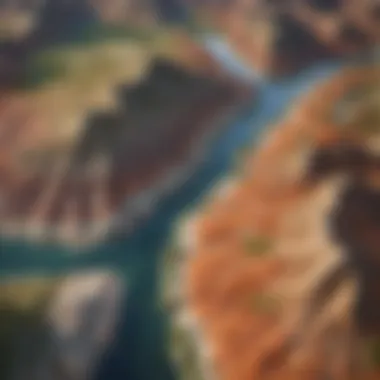Discovering Topographic Features with Google Earth


Intro
In today’s fast-paced world of technology, understanding the planet's topography has never been easier. Google Earth stands at the forefront, offering a user-friendly interface to dissect the Earth's diverse landscapes. This tool allows not just for exploration but also for analytical study and research. Whether you're a student looking to enhance your geographical knowledge or a scientist conducting detailed environmental studies, the significance of delving into the topographic features of Google Earth cannot be overstated.
Overview of Research Topic
Brief Background and Context
Google Earth, launched back in 2005, revolutionized how we interact with maps and geographical data. With just a few clicks, users can zoom in on remote locations or view intricate terrain layouts. From a wide-angle view of the Rockies to a close-up of the Great Barrier Reef, this software presents a treasure trove of topographic data. Moreover, it showcases 3D imagery that helps simulate the Earth's diverse elevations and depressions. This visual aspect transforms conventional map reading into an immersive experience.
Importance in Current Scientific Landscape
The importance of Google Earth extends beyond casual exploration. It serves as an indispensable tool in various disciplines like geology, ecology, and urban planning. Research conducted using its data can pinpoint environmental changes, track wildlife migrations, or assess urban expansion.
The platform has become a vital resource for educational institutions as well. Teachers employ Google Earth to facilitate interactive lessons, helping students visualize complex ideas and theories. It's not just about learning; it's about experiencing the Earth's environment through a digital lens.
"Google Earth empowers users to explore and analyze the world in a way that traditional maps and atlases could never achieve."
Methodology
Research Design and Approach
To effectively utilize Google Earth's topographic features, understanding the methodology employed is essential. The research design typically revolves around a systematic approach to examining specific locations and collecting pertinent data. This can involve setting objectives, such as determining elevation changes in a particular area or analyzing the effects of human activity on natural landscapes.
Data Collection Techniques
Data collection on Google Earth can happen through various methods:
- Direct Observation: Users can navigate and observe features in real-time.
- Using Historical Imagery: This feature allows for the comparison of landscapes over time, revealing changes due to natural disasters or urban development.
- Utilizing KML Files: Keyhole Markup Language files enable users to create personalized maps and share insights with a broader audience. This fosters collaboration in research projects.
By employing these techniques, users can build insightful research projects that highlight the multifaceted nature of Earth’s topography. Understanding these fundamental techniques sets the stage for deeper explorations of the tool's capabilities and applications in real-world scenarios.
Prologue to Google Earth
In an age where geographic information can shape policy and public awareness, Google Earth stands out as a prominent tool for visualizing our world. This section sheds light on the integral role that Google Earth plays in understanding topography and geographical nuances. With its robust features, it's not just a digital globe but a gateway to comprehending Earth's diverse landscapes.
Whether one is an educator looking to enrich classroom discussions, a researcher gathering data for a scientific study, or simply a curious individual, Google Earth provides layers of information that can unveil the intricate relationship between humans and their environment. The software allows users to analyze terrain elevations and visualize specific geographical features—concepts critical to various fields such as environmental science, urban planning, and geology.
From topographic interpretations to geographical analyses, its functionality is vital. The ensuing sections will discuss its evolution, significance in geographic studies, and various applications, serving as a comprehensive guide for anyone keen on unraveling the complexities of our planet.
Overview of Google Earth and Its Development
Google Earth has journeyed remarkably since its inception. Originally launched in 2001 as Keyhole, Inc's EarthViewer, it was rebranded in 2005 after Google acquired the company. This transformation not only broadened its user base but also integrated heavy-duty graphical capabilities and extensive datasets, making it accessible for the public and professionals alike.
Over the years, Google Earth has been enhanced with various updates, including the addition of 3D terrain, satellite imagery, and even street-level views. These innovations have taken mapping and geographical exploration to places that books and atlases simply can't reach.
Crucially, Google Earth continuously updates its databases, ensuring that users have access to the latest information available, which is pivotal for accurate environmental studies and urban planning initiatives.
Significance of Topography in Geographic Studies
Topography forms the backbone of geographical studies. It guides researchers in understanding physical phenomena and environmental trends. By studying terrain shapes, slopes, and elevational variations, insights can be gleaned about weather patterns, ecosystems, and even human activity.
Consider the following points on the relevance of topography:
- Natural Resource Management: Understanding landforms can help in locating natural resources, such as minerals and water sources, thus influencing economic decisions.
- Hazard Assessment: Topographical features play a crucial role in assessing risks linked to natural disasters, like floods, landslides, or earthquakes. By visualizing elevation and slopes, researchers can pinpoint vulnerable areas for intervention.
- Biodiversity: Different topographical features can affect vegetation and animal life, revealing the rich tapestry of Earth’s ecosystems.


"Topographical understanding enables us to not just see where we live but comprehend how our environment and landscape shapes life itself."
Through the lens of topography, tools like Google Earth can furnish valuable insights that drive sustainable practices, informed planning, and enhanced research methodologies crucial for our ever-evolving relationship with our planet.
Understanding Topography
Topography plays a crucial role in the study of landscapes, significantly influencing ecological, hydrological, and geological processes. Understanding topography is not just about understanding hills and valleys. It encompasses the features that shape our environment and how they interact with various elements, including climate and vegetation. Topographic data is vital for creating accurate maps, evaluating land use, and fostering sustainable practices.
When navigating Google Earth, the importance of topography becomes even more apparent. The software provides unique insights into the structural and functional aspects of the Earth's surface. By grasping the intricacies of topographic data, users can enhance their understanding of different geographical phenomena, such as erosion or sedimentation.
Definition and Relevance of Topographic Data
Topographic data refers to the detailed description of a land surface, capturing the positions of physical features such as hills, valleys, water bodies, and human-made structures. This data is typically represented in a three-dimensional manner, allowing users to visualize variations in elevation and surface relief.
The relevance of topographic data in research and education cannot be overstated. It provides the foundation for various fields, including:
- Environmental Science: Understanding ecosystems and their responses to changes in the landscape.
- Urban Planning: Managing space effectively for sustainability in rapidly growing areas.
- Geology: Analyzing geological formations and the processes that shape Earth’s surface.
Having accurate topographic data aids in simulations that rely on terrain characteristics. This information empowers scientists and educators to make informed decisions based on tangible spatial analysis.
"Topographic data not only informs us about the land but also about human interaction with that land."
Key Elements of Topographic Maps
Topographic maps serve as essential tools for representing Earth's surface. Understanding their key elements can enhance how one navigates through Google Earth. A topographic map incorporates several distinct features:
- Contour Lines: Indicate elevation levels and help illustrate the steepness of slopes. Close lines suggest steep terrain while spaced lines indicate gradual slopes.
- Scale: Provides the relationship between a mapped distance and the actual distance, crucial for determination of area and distance.
- Symbols: Represent natural and man-made features like roads, rivers, and buildings, aiding in navigation.
- Legend: Explains the symbols used on the map, rendering it accessible for users unfamiliar with the specific characteristics of the scenery depicted.
Each component has its significance. Contour lines, for instance, can show not just elevation but also how water flows through an area, affecting everything from biodiversity to potential flood zones.
Navigating Google Earth with a solid understanding of topography allows for informed exploration of Earth’s surfaces, making connections between the digital representation and real-world geographical features. This comprehension is particularly vital for students and researchers who rely on accurate visualizations for their work.
Google Earth's Topographic Features
Understanding Google Earth's topographic features is crucial for grasping the landscape visualization tools at our disposal. These tools musn't just be seen as bells and whistles, but rather as essential components that allow users to perceive and analyze Earth’s surface intricacies. From a geographical standpoint, topography impacts everything from weather patterns to human settlement. Thus, when using Google Earth, the topographic features essentially serve as a digital mind map, guiding users through the complexities of our planet’s elevations, depressions, and everything in between.
Elevation Models and Visualization Tools
Elevation models within Google Earth provide a 3D representation of the Earth's topography. At first glance, this might seem straight-forward, but it extends far beyond simple mountain ranges. Using these models allows researchers and educators alike to comprehend how various elevations affect not just the scenery, but also elements like climate, flora, and fauna. Google Earth's elevation data is derived from multiple sources—satellite imagery, aerial photographs, and ground surveys—combined to create a seamless digital landscape.
For example, visualizing the Rocky Mountains versus the Great Plains is not just about eye-catching peaks and valleys; it's an exploration into ecosystems that thrive in these divergent environments. Whether you are examining a densely forested slope or a barren desert, these models provide a tangible way to engage with the environment, making topography come to life.
Working with the tools in Google Earth is pretty intuitive, though depending on what data you are looking to analyze, there are nuances to understand. Users can switch between a 2D view for broader perspectives, or dive into a 3D experience revealing all the minute details. With just a few clicks, you could find yourself evaluating how elevation changes impact river systems or human infrastructure developments.
Interactivity and User Engagement
The interactivity offered by Google Earth is one element that makes the platform so compelling. Users are not just passive observers; they can manipulate the environment in real-time. Zooming into a particular area can unveil hidden details like ravines, glacial paths, or evidence of erosion that might not be immediately apparent on a flat map. Furthermore, the ability to create paths or annotate areas encourages deeper investigation, inviting users to engage with the data rather than simply consume it.
"Interactivity turns passive observation into active exploration, challenging the user to think critically about what they see."
Interactive features—like toggling different layers—allow users to visualize weather patterns, population densities, or even historical changes in the landscape. This makes Google Earth a valuable tool for educators, offering innovative ways to discuss geographical and environmental concepts in classrooms. By immersing students in active learning, the potential for breakthroughs in understanding geographical phenomena considerably increases.
Layering and Customization Options
One of the most fascinating aspects of Google Earth is its extensive layering capabilities. Users have the option to display multiple data layers simultaneously, whether it's streets, satellite imagery, or terrain data. This multifaceted approach allows for a rich, well-rounded understanding of the geographical space.


For instance, an urban planner could layer demographic data with topographic models to explore how elevation might influence city expansion. Such functionality makes it possible for professionals to tailor their views based on project requirements, ensuring they have all the pertinent information at their fingertips.
Furthermore, custom maps or user-generated content can be integrated. This enhances community engagement, allowing individuals to contribute their local knowledge and experiences. The ability to draw, annotate, or highlight areas of interest is particularly useful in collaborative environments or research settings. This feature ensures each user’s interaction with the tool can differ dramatically, based on personal preferences and the goals they aim to achieve.
In summary, Google Earth’s topographic features do not merely provide aesthetics; they are fundamental to developing a comprehensive understanding of our planet’s complexities. By integrating elevation models, enhancing user engagement, and offering substantial customization options, Google Earth stands as an invaluable resource for students, educators, and professionals in grasping the nuances of geography.
Applications of Google Earth in Research
Google Earth serves as a remarkable tool for research across various disciplines, enabling in-depth explorations of geographical features, environmental changes, and urban developments. The platform has gained prominence for its ability to provide visual and quantitative data, which researchers can utilize to gain insights into complex subjects. This section outlines the integral role of Google Earth in academic and practical applications, underscoring methods and benefits for different fields of study.
Use in Environmental Studies
In the realm of environmental studies, the potential of Google Earth is simply astounding. Researchers can analyze landscapes, monitor environmental degradation, and track the movements of wildlife habitats. For instance, one can observe seasonal changes in vegetation or the impact of human activities like deforestation. By employing satellite imagery, scientists can visualize long-term trends related to climate change, including rising sea levels and diminishing ice caps.
There is a wealth of information available at one’s fingertips, from exploring coastlines to assessing changes in river patterns—all invaluable for understanding ecological dynamics. Moreover, Google Earth's ability to overlay different data sets facilitates comparative analysis and enhances the understanding of how various factors interplay in our environment.
"Google Earth is not just about maps; it’s a window to our planet’s changing landscape, providing a unique perspective on pressing environmental issues."
Application in Urban Planning and Development
Urban planners harness Google Earth to enhance their decision-making processes. The platform's topographic features, coupled with its 3D visualization, allow planners and developers to visualize the potential impact of new projects on existing landscapes. By studying terrain features and infrastructure, they can make informed decisions on zoning, transportation, and resource allocation.
For example, before launching a new housing project, it is essential to evaluate the site's topography for stormwater management. Google Earth makes this task easier by providing real-time data that can showcase flood-prone areas or upland sites suitable for development. Furthermore, community engagement improves through accessible visualizations, as residents can better understand proposed changes to their neighborhoods.
Role in Geological and Geographical Research
Geological research benefits immensely from Google Earth, providing geologists datasets that help them map and analyze geological formations. The platform allows researchers to view an area’s physical characteristics, such as rock types and fault lines, which are crucial for understanding tectonic movements and predicting natural disasters, including earthquakes or landslides.
Geographical research is also enriched by this tool. Scholars can document changes in land use, study urban sprawl, and assess the social-economic impacts of geographical factors. The high-resolution images help in creating detailed geographic information systems (GIS), which are instrumental in diverse research areas, including sociology, anthropology, and urban design.
Educational Resources through Google Earth
In the age of digital learning, tools that enhance educational experiences are more crucial than ever. Google Earth, with its unique topographic features, can serve as a powerful resource in both formal and informal educational settings. By integrating this platform into the learning process, educators can foster a greater understanding of geographical concepts while bringing the physical world right into their classrooms.
Integrating Google Earth in Classroom Settings
One of the standout aspects of using Google Earth in the classroom is its ability to transform traditional lessons into interactive journeys. Imagine a history lesson on ancient civilizations where students visually explore the ruins of the Mayan pyramids or the Great Wall of China from their desks. This kind of engagement can't be replicated through mere textbooks.
Moreover, teachers can create customized lesson plans that utilize Google Earth's layers and features. For instance, during a lesson on plate tectonics, students can observe current geological activity alongside historical data capturing continental shifts. This multifaceted approach not only solidifies their understanding but allows them to visualize concepts that are otherwise abstract.
In this dynamic learning environment, collaboration is key. Students can work in groups, sharing insights and findings as they navigate through different geographical regions. It can be akin to a virtual field trip, where each student contributes their unique perspective.
Resources for Self-Learning and Exploration
Even outside the classroom, Google Earth provides bountiful resources for self-learning and exploration. Individuals of all ages can dive into a plethora of topics driven by their interests. For a curious mind, the sky's the limit.
- Curated Educational Content: Google Earth features a plethora of curated content, such as guided tours and historical map layers that allow users to explore different topics on their own pace.
- User-Generated Content: Learners can also create their own maps, adding points of interest or personal stories related to a specific area. This hands-on approach solidifies knowledge while promoting creativity.
- Supplementary Learning Resources: Various websites, like Britannica and Reddit, offer additional information and discussions on geological topics, encouraging deeper dives into subjects encountered while using Google Earth.
"Digital technology, such as Google Earth, transforms our approach to education, turning passive learning into active exploration."
In summary, the integration of Google Earth as an educational tool offers remarkable benefits that can inspire students and lifelong learners alike. With its engaging visualization features, educators can captivate their audience, while self-learners can explore the treasures of our planet at their own pace. The combination of these resources presents a unique opportunity for enriched learning experiences.
Limitations of Google Earth for Topographic Analysis
While Google Earth is a powerful tool for visualizing and analyzing topographic features, it is not without its limitations. Understanding these constraints is crucial for researchers, educators, and students who depend on accurate and reliable geographical data. Recognizing the limitations of Google Earth helps users make informed decisions and set realistic expectations when using the platform for topographic analysis.


Resolution and Accuracy Issues
One significant limitation of Google Earth is its resolution and accuracy. The imagery available may vary greatly based on multiple factors such as the location, the age of the satellite data, and the level of detail captured. For instance, urban areas may showcase higher resolution images compared to remote or rural locations, where satellite imagery might be blurry or less detailed. This inconsistency in resolution can be problematic when trying to conduct precise topographic measurements.
- High-resolution imagery: Often only available for densely populated areas.
- Older imagery: May not accurately represent current land use or natural features.
"Resolution of satellite imagery can skew analysis, leading to erroneous interpretations of landform features."
Accurate elevation data is particularly vital in various applications, from environmental assessments to urban planning. When users encounter low-resolution images, they might misinterpret slopes, depressions, or other critical geographical features. Thus, relying too heavily on Google Earth for topographic data without verifying the information from additional sources can potentially lead to misguided conclusions.
Dependence on Internet Connectivity
Another crucial limitation is Google Earth's reliance on internet connectivity. Efficient usage of the platform demands a stable and fast connection to access high-definition imagery and up-to-date data layers. This reliance becomes a hurdle, particularly in areas with poor network coverage or in regions where internet access is limited or non-existent.
- Streaming data: Users need to download maps and imagery, which can be cumbersome in offline scenarios.
- Data accessibility: Inconsistent access to the latest datasets can hinder analysis, making timely information gathering difficult.
This can pose challenges for educators and researchers who may wish to demonstrate or analyze features in real-time. In classrooms or fieldwork scenarios where connectivity is unreliable, the effectiveness of Google Earth as a teaching tool can be significantly diminished. Consequently, users should consider alternative resources or offline tools when navigating difficult connectivity landscapes.
In summary, while Google Earth provides an impressive platform for exploring topography, acknowledging its limitations is critical for ensuring valid analysis and conclusions. Users should always consider complementing their findings with other reliable data sources to enhance their understanding of the world around them.
Future Prospects and Innovations
The realm of topographic mapping is evolving at a brisk pace, and Google Earth stands at the forefront of this transformation. As technology advances, so do the tools that allow us to vicariously traverse our planet. This section not only highlights these innovations but also examines their potential impact on how we understand and interact with Earth�’s diverse terrains.
Advancements in Topographic Mapping Technologies
In recent years, notable enhancements in topographic mapping technologies have emerged, improving the granularity and reliability of data. Some of these advancements include:
- LiDAR Technology: Light Detection and Ranging (LiDAR) has revolutionized how elevation data is collected. This system employs laser beams to measure distances, producing highly detailed and accurate elevation models. As access to LiDAR data improves, users can glean insights into complex landscapes, such as forests or urban environments, with an unparalleled level of detail.
- Drone Mapping: Unmanned aerial vehicles (UAVs), better known as drones, offer a new way to capture topographical features. They can fly lower and maneuver better than traditional aircraft or satellites, enabling more detailed surveys of hard-to-reach areas.
- 3D Terrain Visualization: The shift from 2D to 3D representations provides a more immersive experience for users. Google Earth's incorporation of 3D models allows for a more intuitive understanding of landforms, giving users the ability to visualize not only the height of a mountain but also its contours and textures.
These technologies not only heighten the accuracy of topographic data but also broaden accessibility. As Google Earth continues to integrate these cutting-edge tools, both casual explorers and serious researchers gain the ability to engage with geographic data in unprecedented ways.
Integration of Artificial Intelligence in Google Earth
The infusion of artificial intelligence (AI) into geographical exploration heralds a new era in topographic analysis. By leveraging machine learning algorithms, Google Earth can offer more than just visual data; it can interpret and analyze complex patterns within that data.
Consider these aspects of AI integration:
- Predictive Analysis: AI can identify patterns in topographic changes over time, assisting in predictions about future terrain shifts due to factors like climate change or urban development. This could be invaluable for both researchers and policymakers.
- Automated Feature Detection: By employing advanced image recognition, Google Earth can automatically detect and classify various geographical features. This saves significant time and increases the accuracy of data collection compared to manual surveys.
- Customized Users Interfaces: AI can adapt interfaces based on user behavior, offering tailored experiences that cater to individual needs. For instance, a geological researcher might access different layers of information compared to a casual user interested in hiking trails.
As AI continually integrates into platforms like Google Earth, the implications are profound. It encourages not only a deeper understanding of landscapes but also promotes environmentally responsible decision-making in fields that rely heavily on geographical analysis.
"As technology evolves, so too does our ability to understand and preserve the world around us. The future is promising for topographic explorations on platforms like Google Earth."
Epilogue
The exploration of Google Earth's topographic features presents a unique avenue for understanding our planet's diverse physical characteristics. This article synthesizes various aspects of Google Earth, illustrating not just the digital tool’s capabilities but also emphasizing its relevance across educational and research disciplines.
Through our detailed discussions, we highlighted the importance of topographic data and how it aids in visualizing geographical phenomena. The functionalities of Google Earth empower users to engage with real-world terrains, thus benefiting students, educators, and researchers alike. In each section, we presented specific functionalities, from layering options to interactive models, demonstrating how these elements enhance geographic comprehension. Moreover, we discussed the practical applications of these tools in real-world scenarios. By utilizing Google Earth, professionals can make informed decisions in environmental studies, urban planning, and more.
Summary of Key Points
- Google Earth provides a user-friendly platform for visualizing topographic features, making complex geographical data accessible to a broader audience.
- Interactivity and customization options, such as layering and elevation models, allow users to tailor their analysis based on specific research needs.
- The tool's applications extend beyond simple visualization; it is used in a variety of fields including urban planning and environmental studies.
- Challenges like resolution limitations and internet dependency are important considerations when using Google Earth for in-depth analysis.
- Innovations in topographic mapping technologies and potential integration of AI hint at a future rich with possibilities for enhancing user engagement and data accuracy.
Implications for Future Research and Education
Looking ahead, the implications of utilizing Google Earth in research and education are far-reaching. As advancements in technology continue, the integration of such tools in academic curricula could dramatically elevate the learning experience. Institutions could leverage Google Earth to facilitate interactive learning, thereby fostering a deeper understanding of geography among students. For researchers, continuing to refine the capabilities of Google Earth offers opportunities for greater accuracy in topographical studies and environmental assessments.
The marriage of technology and education, coupled with ongoing developments in geographical tools, not only expands our understanding of Earth’s landscapes but also promotes sustainable practices in various fields. Encouraging future generations to engage with digital geography platforms like Google Earth may well inspire innovative solutions to pressing environmental challenges. Therefore, fostering an appreciation for such technologies in academic settings is crucial as we move forward into a more interconnected and environmentally conscious future.
"The Earth is what we all have in common." – Wendell Berry
"



